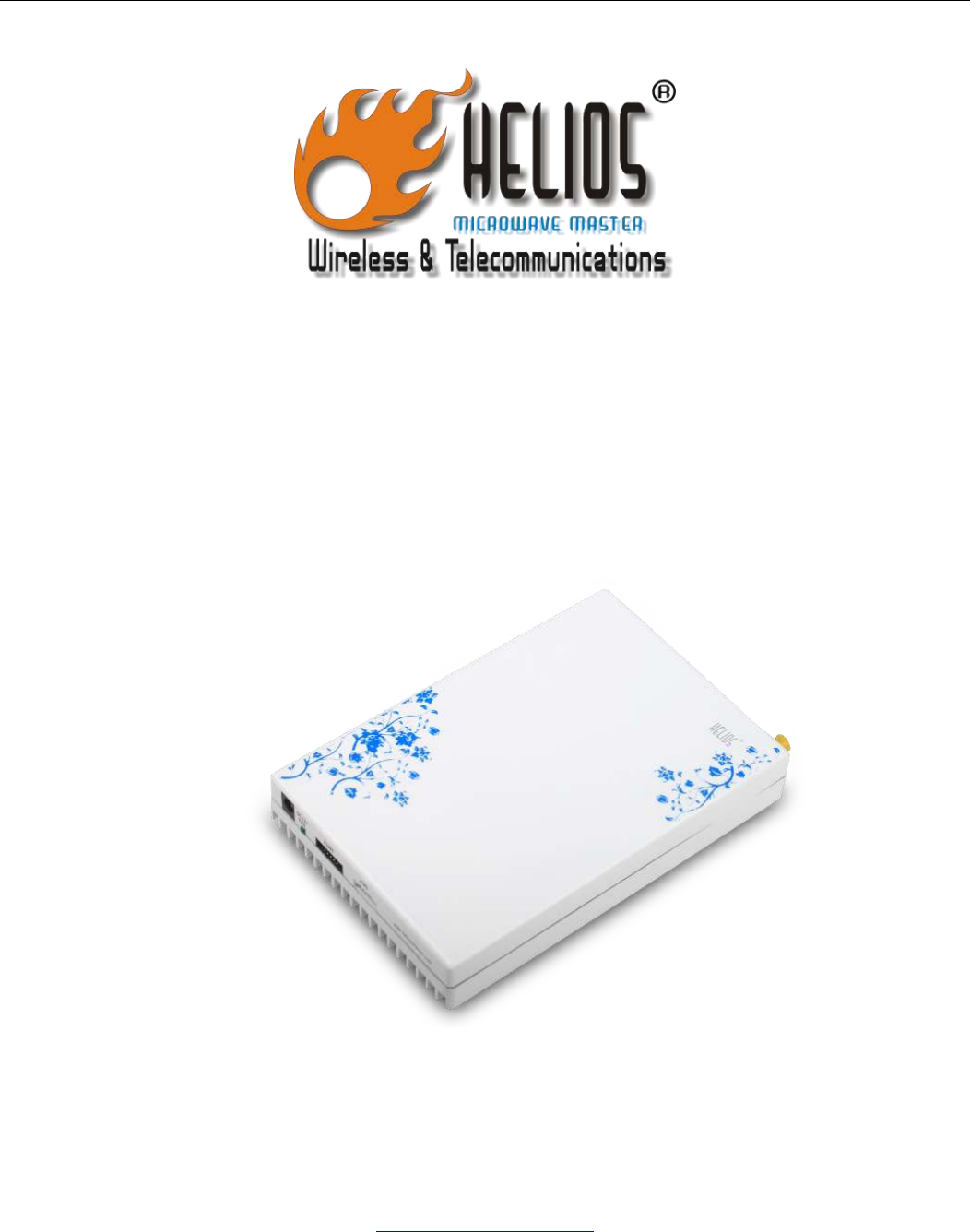Fujian Helios Technologies HETD26L TD-LTE Digital Repeater User Manual
Fujian Helios Technologies Co., Ltd. TD-LTE Digital Repeater
User Manual
2
Contents
Copyright ............................................................................................................................................................................................................ 3
Disclaimer .............................................................................................................................................................................................................. 3
Warning ............................................................................................................................................................................................................................ 4
1 Overview ................................................................................................................................................................................................................ 5
2 Illuminating ........................................................................................................................................................................................................... 5
3 Product Overview ............................................................................................................................................................................................... 6
4 Main Features ....................................................................................................................................................................................................... 6
5 Application Diagram .......................................................................................................................................................................................... 7
6 Technical Specification ..................................................................................................................................................................................... 7
7 Typical Applications .......................................................................................................................................................................................... 9
8 Optional Accessories ......................................................................................................................................................................................... 9
9 Installation ............................................................................................................................................................................................................. 9
10 Commissioning ........................................................................................................................................................................................ 10
11 Local Control ............................................................................................................................................................................................. 10
11.1 Hardware Connection ........................................................................................................................................................................... 10
11.2 System Requirements ........................................................................................................................................................................... 10
11.3 Software Installation .............................................................................................................................................................................. 11
11.4 Log on .......................................................................................................................................................................................................... 11
11.5 Basic Info .................................................................................................................................................................................................... 13
11.6 Alarm Info .................................................................................................................................................................................................. 14
11.7 Timeslot Set ............................................................................................................................................................................................... 14
11.8 Advance ...................................................................................................................................................................................................... 15
11.9 Hardware ................................................................................................................................................................................................... 17
11.10 Setup Wizard.......................................................................................................................................................................................... 18

3
Copyright
© Copyright Helios Telecom. All rights reserved.
The copyright of this document is owned by Fujian Helios Technologies Co., Ltd. without the prior
written permission obtained from Fujian Helios Technologies Co., Ltd., this document shall not be
reproduced and excerpted in any form or by any means, stored in a retrieval system, modified,
distributed and translated into other languages, applied for a commercial purpose in whole or in
part.
Disclaimer
This document and the information contained herein is provided on an “AS IS” basis. Helios® may
make improvement or changes in this document, at any time and without notice and as it sees fit.
Fujian Helios Technologies Co., Ltd.
4/F, Helios Building, No. 12 Xiangyue Road,
Torch Hi-Tech Industrial Zone, Xiangan District,
Xiamen P.R.China 361100
Phone: +86-592-5785219, 5785229
Fax: +86-592-5785239
E-mail: info@heliostelecom.com
Website: http://www.heliostelecom.com
Local Representativ

Fujian Helios Technologies Co., Ltd.
www.heliostelecom.com
4
Warning
The product has been tested and found to comply with the Federal Communications Commission(FCC) RF
Exposure Requirements,pursuant to FCC Part 27.
The Manufacturer’s rated output power of this equipment is for single carrier operation. For situations when
multiple carrier signals are present, the rating would have to be reduced by 3.5dB,especially where the output
signal is re-radiated and can cause interference to adjacent band users. This power reduction is to be by means
of input power or gain reduction and not by an attenuator at the output of the device.
In order to comply with the FCC RF exposure requirements, the BDA-CELLAB/PCSF-33/33-80-AB antenna
installation must comply with following:
The base station antenna must be installed so as to provide a minimum separation distance of 60cm between the
antenna and persons within the area.This antenna should with gain less than 11dBi ,VSWR≤1.5:1,ZO=50ohms)
The service antenna must be installed so as to provide a minimum separation distance of at least 25cm between
the indoor antenna connected to the RF booster and the human user’s body within the area. This antenna should
with gain of 0-7dBi,VSWR≤2:1, ZO=50ohms.
INSTALLATION
WARNING:This is NOT a CONSUMER device.It is designed for installation by FCC
LICENSEES and QUALIFIED INSTALLERS.You MUST have an FCC LICENSE or
express consent of an FCC Licensee to operate this device.Unauthorized use may result in
significant forfeiture penalties,including penalties in excess of $100,000 for each
continuing violation.

Fujian Helios Technologies Co., Ltd.
www.heliostelecom.com
5
Thanks for choosing Helios Pico Repeaters, please read the User Manual
carefully before using the repeater.
1 Overview
TDD-LTE, also known as TD-LTE, was adopted as the evolution of choice for TD-SCDMA,
China’s 3G standard. Compare with LTE FDD, LTE TDD uses a different approach, a single
frequency sharing the channel between transmission and reception, spacing them apart by
multiplexing the two signals on a real time basis. While FDD transmissions require a guard
band between transmission and reception, TDD schemes require a guard time or guard
interval between transmission and reception.
For TD-LTE operators, they must optimize their network and offer best service to users to
improve their competitive ability. However, and 4G signals attenuate severely when traveling
through walls, floors, and windows, leaving more than 50% of all indoor spaces with
inadequate coverage and poor data throughput. Then the operators need a cost-effective
solution to resolve such coverage problems easily and rapidly.
Repeaters, Boosters and Amplifiers for mobile network are to relay RF signals for both uplink
and downlink, they are effective tools to enhance mobile network coverage for telecom
operator, but there are one of the key technologies for the Repeaters, Boosters and Amplifiers
with TDD mode must be first resolved, which is Frame Synchronization, without accurate &
reliable TDD Frame Synchronization with BTS, the Repeaters will be unable to normally
switch between the different time-slots for uplink and downlink and working in harmony with
macro network, even will cause big air-interference to macro network.
With ultra-low-noise RF frontend, innovative digital filter, high SFDR (Spurious Free Dynamic
Range) ADC, patented TD-LTE frame synchronization algorithms in SDR, TDD-Mate enables
accurate, speedy and reliable frame synchronization with TD-LTE BTS and working in
harmony with macro network. It receives TDD signal from BTS and down-converts to IF
signals firstly, then digitalizes signal via high speed ADC and implements baseband
demodulation on DSP, and Identifies PSS in DwPTS and SSS in TS0 according to TD-LTE
frame structure, and acquire the accurate switch point between UpPTS and DwPTS.
Helios TDD-Mate series TD-LTE ICS Pico Repeater is designed for industry users looking to
enhance TD-LTE indoor wireless connectivity. It will be connected via coaxial cable to an
outside Donor Antenna, whereas Service Antenna is built-in inside the repeater. Donor
Antenna is placed outside the building where it has easy access to TD-LTE BTS signal, and
the Pico Repeater with built-in Service Antenna is placed in the building where it can extend
TD-LTE radio coverage to the blind area.
2 Illuminating
Uplink: Communication link from handset to BTS.
Downlink: Communication link from BTS to handset.
Self-oscillation: An amplified signal being received & amplified again by repeater is called
self-oscillation that will cause components fault.
ICS:The Interference Cancellation System, which can automatically detect and eliminate all
multi-path feedback signals. It can moderate the requirements of isolation between donor
antenna and service antenna.
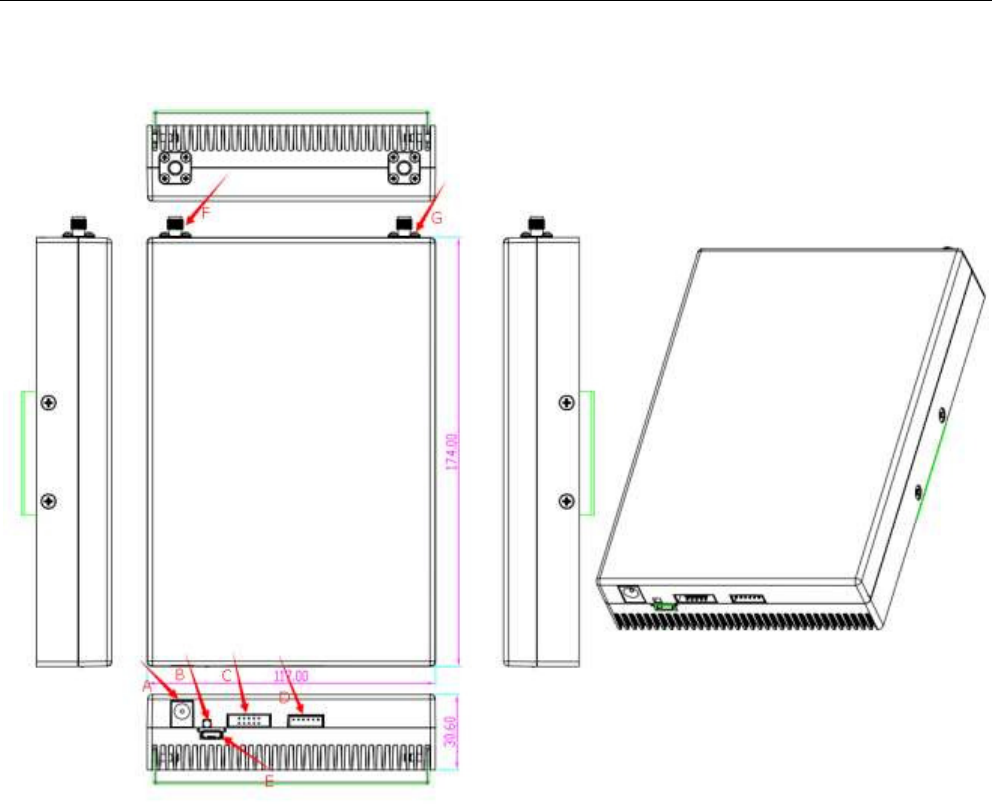
Fujian Helios Technologies Co., Ltd.
www.heliostelecom.com
6
3 Product Overview
A. DC-12V: Connect to AC/DC power adapter, input voltage is +12VDC
B. PWR indicator: Green LED for power supply indicator
C. RS485 port: Connect to laptop via RS485 cable for local control
D. JTAG port: Reserved for manufacturer only
E. Micro-USB port: Connect to laptop via Micro-USB cable for local control
F. MSport: SMA type female connector for service antenna
G. BTS port: SMA type female connector for donor antenna
4 Main Features
Support single band TD-LTE2300MHz, 2500MHz and 2600MHz.
Built-in Patented TDD-Mate™ frame synchronization algorithm for TDD system to
ensure accurate synchronization and eliminate interfere to macro network.
Built-in patented ICS (Interference Cancellation System) arithmetic in DSP to ensure
stable operation.
High working gain as Min. 70dB significantly improves 4G TD-LTE network capacity
for operators.
Build-in Intelligent Carrier Scan Function (CSF) and auto local cell with best QoS and
RSSI by PSS &SSS, likewise support manually lock expected carrier by software.
Flexible TDD UL/DL Allocations configurable by software (0 to 6), default UL/DL Ratio
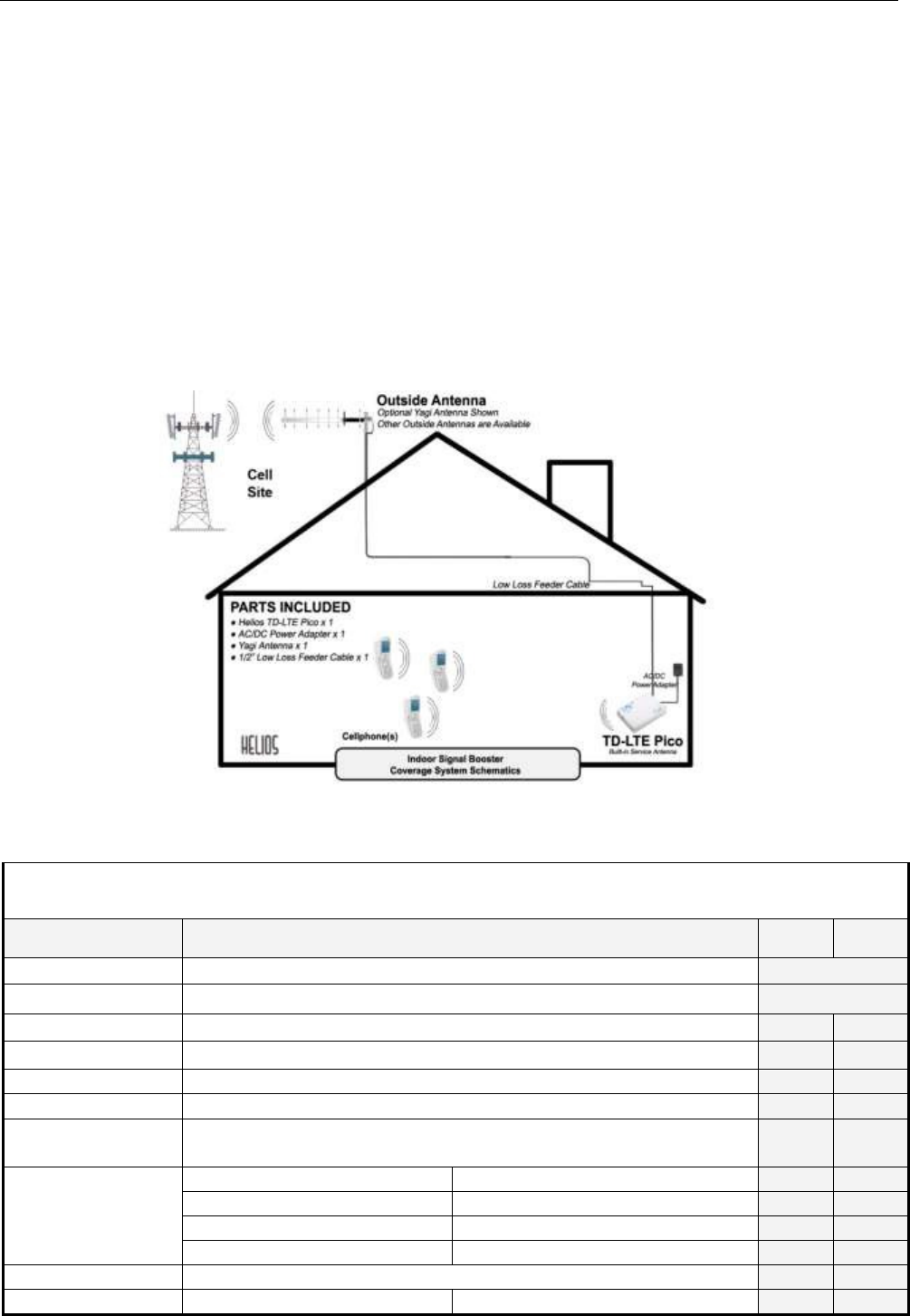
Fujian Helios Technologies Co., Ltd.
www.heliostelecom.com
7
is 1.
Configurable field length of DwPTS/GP/UpPTS by software (0 to 8).
Both support Normal CP (Cyclic Prefix) and Extended CP.
Innovative Digital Filtering and advanced baseband algorithms in SDR to provide
accurate AGC, MGC and Power Control for each time slot with minimum time delay.
Significantly improve data rates in both weak signal areas and most area with good
signal areas.
Lower cost of indoor coverage and rapidly increases capacity of TD-LTE wireless
networks.
Significantly improve Battery Life of subscribers’ handset and UE.
Automatic Gain Control (AGC) continuously monitors path loss and transmit power to
deliver max gain.
Optional wireless modem for remote monitoring by SMS, GPRS or TCP/IP.
5 Application Diagram
6 Technical Specification
TD-LTE PICO QA INSPECTION RECORD
Items
Technical Specification
DL
UL
Freq Range
2570~2620MHz
Working Bandwidth
Total working bandwidth 50MHz, 20MHz/carrier, total 2 carriers
Output Power
DL: 15±2dBm;UL: 15±2dBm
Gain
DL: 70±2dB;UL: 70±2dB
Frequency Error
≤0.01ppm (RMS)
EVM
EVM≤8%
Input Intermodulation
the spurious on Central frequency ≤10dB@RBW1MHz compare to without the
input interference singals (F1,F2).F1=F0±1MHz,F2=F0±11MHz
Out of Band gain
(from the edge of
transmit band)
0.2~1MHz offset
60.5dB
1~5MHz offset
45.5dB
5~10MHz offset
45.5dB
>10MHz offset
35.5dB
Noise Figure
≤8dB
Spectrum Emission Mask
0.05MHz~5.05MHz
≤-7~14dBm
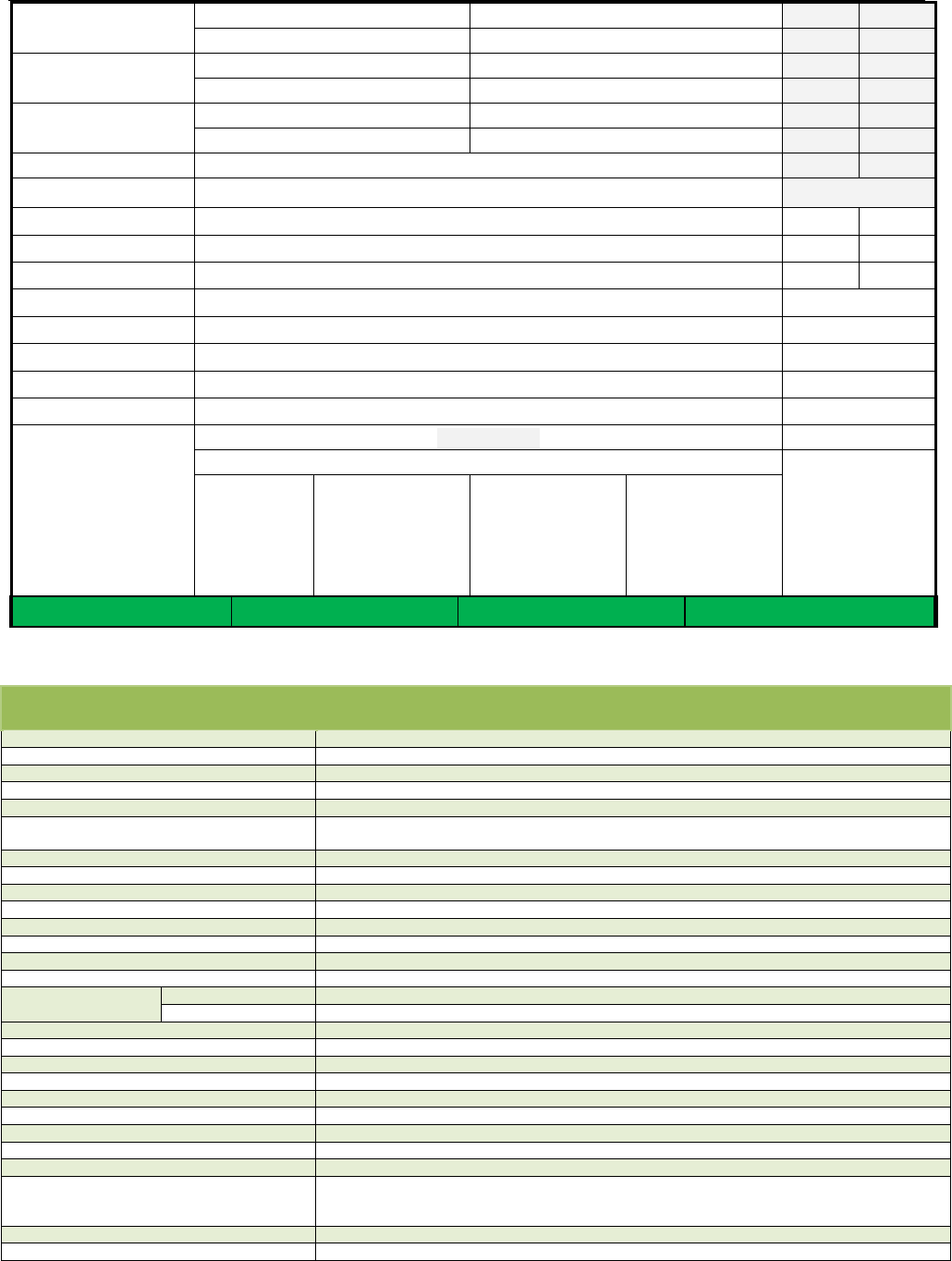
Fujian Helios Technologies Co., Ltd.
www.heliostelecom.com
8
5.05MHz~10.05MHz
≤-14dBm
10.05MHz~offset-max
≤-15dBm
Spurious Emissions
9kHz ~1GHz
≤-36dBm@RBW100KHz
1GHz ~12.5GHz
≤-30dBm@RBW1MHz
ACRR
5MHz
> 20dB
10MHz
> 20dB
Output Intermodulation
ETSI TS 136 106
Synchronization Range
-90~-40dBm
Maximum Input Power
-10dBm, 1 minute
Input Power Detection
Detection Range for each time slot: -80dBm~-20dBm
Output Power Detection
Detection Range for each time slot: -20dBm~+15dBm
Power Supply
DC +12V
Power Consumption
≤14W
Temperature Range
0℃~50℃
RF Connector
SMA Type Female, 50Ω
Dimensions
172.5*114.5*29 (mm)
Monitoring Interface
Micro USB 2.0
RS485 protocol, compatible with common protocol
Box-Header
Pitch 2*5
1: 485-A
3: 485-B
5: GND
7: SWDIO
9: GND
2: 485-A
4: 485-B
6: GND
8: SWCLK
10: +3.3V
CONCLUSION
TEST ENGINEER
APPROVED
ISSUED STAMP
Other Technical Specification:
Items
Helios®Digital TD-LTE ICS Pico Repeaters
Frequency Range (Customized)
TD-LTE 2.3G, TD-LTE 2.5G, TD-LTE 2.6G
Max Output Power
+15dBm
Working Bandwidth
Customized
TDD UL/DL Allocations Configurable
0 to 6 configurable by software (Default setting is 1)
Cyclic Prefix Configurable
Normal CP or Extend CP configurable by software
Field Length of DwPTS/GP/UpPTS
Configurable
0 to 8 configurable by software
Gain
Min70dB
AGC Control Range
Min 40dB
Gain Control Range
31dB (1dB Step)
VSWR
< 1.5
Ripple in Band
Max +/- 1.5dB
Cancellation Window Size
0 - 6µSec
Interference Cancellation Range
Min. 5dB Gain ≤ )solation + dB
In-band Intermodulation
Complies with ETSI
Spurious
Emissions
9KHz-1GHz
Max -36dBm
1GHz-12.75GHz
Max -30dBm
RF Connector
MCX-type Female for option external Receiver Antenna
I/O Impedance
50 ohm
Noise Figure
Max 5dB
Group Time Delay
Max 6µS
Temperature Range
-25 degree Celsius to +55 degree Celsius
Relative Humidity
Max 95%
MTBF
Min. 100000 hrs
Power Supply
AC220V (+/-15%), 50Hz
Power Consumption
Max 25W
NMS Monitor Function
Real-time alarm for Temperature, RSSI, Input Under Power, Input Over Power, Output Under Power,
Output Over Power, VSWR, Output Power, Gain, Uplink ATT, Downlink ATT, Return Loss, ICS Switch,
Isolation and etc.
Dimensions
224.5mm*164mm*42mm
Weight
2.5Kgs
* Technical Specification subject to change without notice
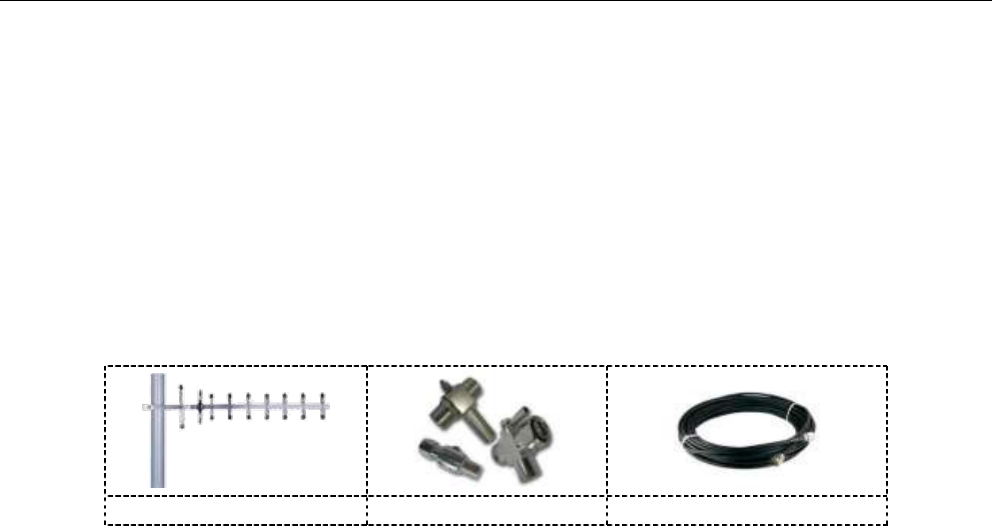
Fujian Helios Technologies Co., Ltd.
www.heliostelecom.com
9
7 Typical Applications
Office, mini basement and so on.
Meeting room, supermarket, marketplace and so on.
Pub, net bar, dance hall, coffee hall, health club, entertainment place, house, office plant,
yacht, public security system and so on.
8 Optional Accessories
Yagi Antenna
Arrester
Low Loss Feeder Cable
9 Installation
A. With the aid of mobile phone or TEMS, find a suitable place to install the donor
antenna on the wall of the building or parapet wall on the top of the building where the
signal bar is full and call quality is good. Note that the height of donor antenna
should be less than 7 floors or 20 meters to ensure good call quality and avoid
interference to the BTS. On the other hand, users should try their best to separate the
donor antenna from the area to be covered as far as possible to ensure the isolation
between the donor antenna and service antenna.
B. Fasten the donor antenna (Yagi or Log antenna) on the selected place, and the donor
antenna should face to the BTS direction.
C. Fasten the TD-LTE ICS Pico Repeater on the wall where is close to the area to be
covered and has available mains socket nearby. The side with Helios logo is service
antenna direction which should face to the area to be covered.
D. Connect the feeder cable to the donor antenna and run the cable to the BTS port of
the TD-LTE ICS Pico Repeater and fasten it along the wall. Note that when the cable
goes from outdoor to indoor, the outdoor section should be made U-type bend to
prevent water goes into indoor place. Remember to have weatherproofing process for
RF connectors.
E. Connect the feeder cable to the BTS port of the TD-LTE ICS Pico Repeater and have
weatherproofing process for RF connectors.
F. Ensure all connections are correct and lock them. Now, the primary installation is
finished.
G. Ensure don’t use unauthorized antennas,cables, and/or coupling devices not
conforming with ERP/EIRP and/or indoor-only use restrictions.
H. Please don`t installed the device in out-door.
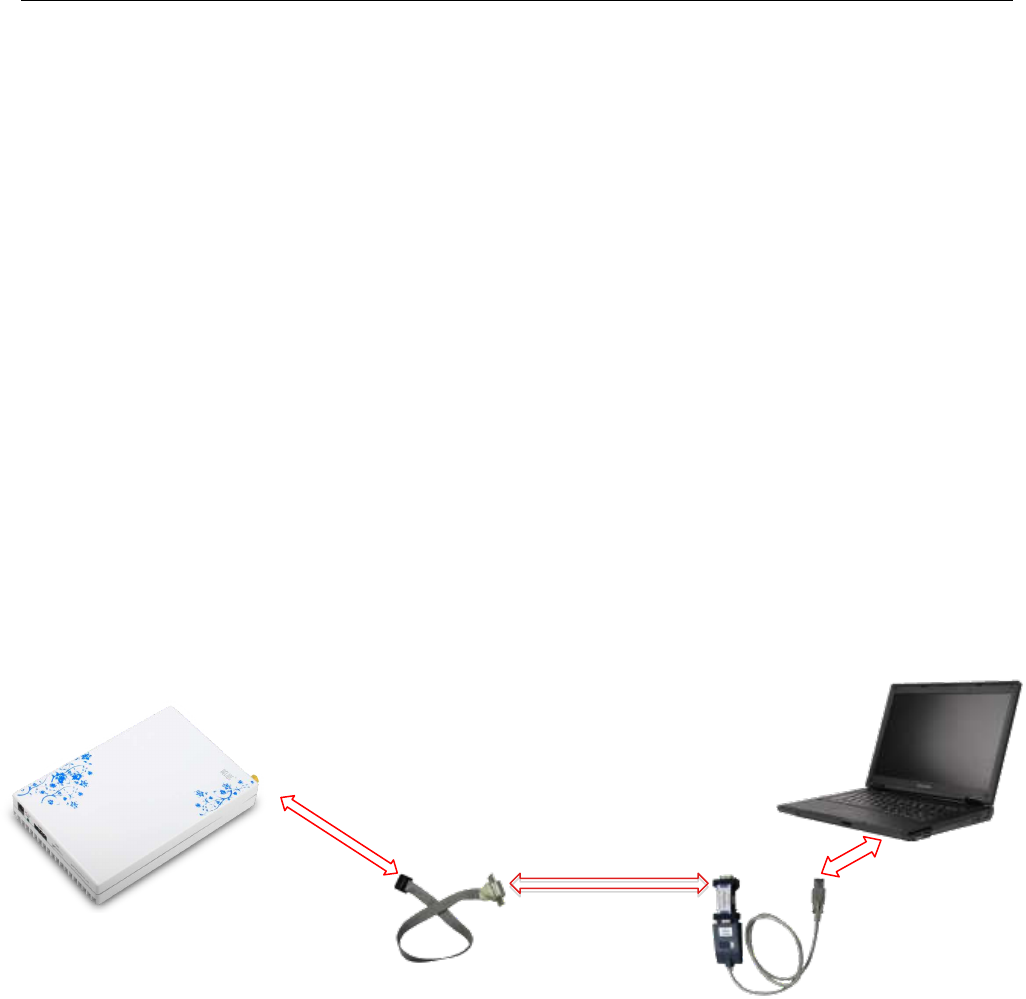
Fujian Helios Technologies Co., Ltd.
www.heliostelecom.com
10
10 Commissioning
1) Plug in the AC/DC power adapter to the nearest 120VAC mains socket, and connect
the DC output port to the DC-12V input port of TD-LTE ICS Pico Repeater.
2) Power On.
3) Check the green PWR LED indicator of TD-LTE ICS Pico Repeater should be light
on.
4) The TD-LTE ICS Pico Repeater can run normally after above process. Users can
have a Walk Test or CQT Test to check the working status and compare the coverage
performance between before and after.
5) If it needs to configure ARFCNs and UL/DL Allocations, please refer to clause 11.
11 Local Control
11.1 Hardware Connection
Connect RS485 Port of TD-LTE ICS Pico Repeater with RS232 port of laptop via
RS485 cable and RS485-RS232 converter. If the laptop doesn't have RS232 port, a
USB-RS232 converter can be used.
11.2 System Requirements
Operating System: Windows XP/2007/2008
CPU: Intel, Pentium, Pentium Pro, Pentium II or higher processor with minimum
speed of 1GHz.
Memory: At least 1GB RAM and 2 GB is suggested to satisfy with minimum
requirements for operating system software.
RS232 port: At least 1 serial COM port or USB-RS232 converter, default baud
rate 9600bps.
TD-LTEICS Pico Repeater
RS485
Cable
RS485-RS232
Converter
USB-RS232
Converter
Laptop
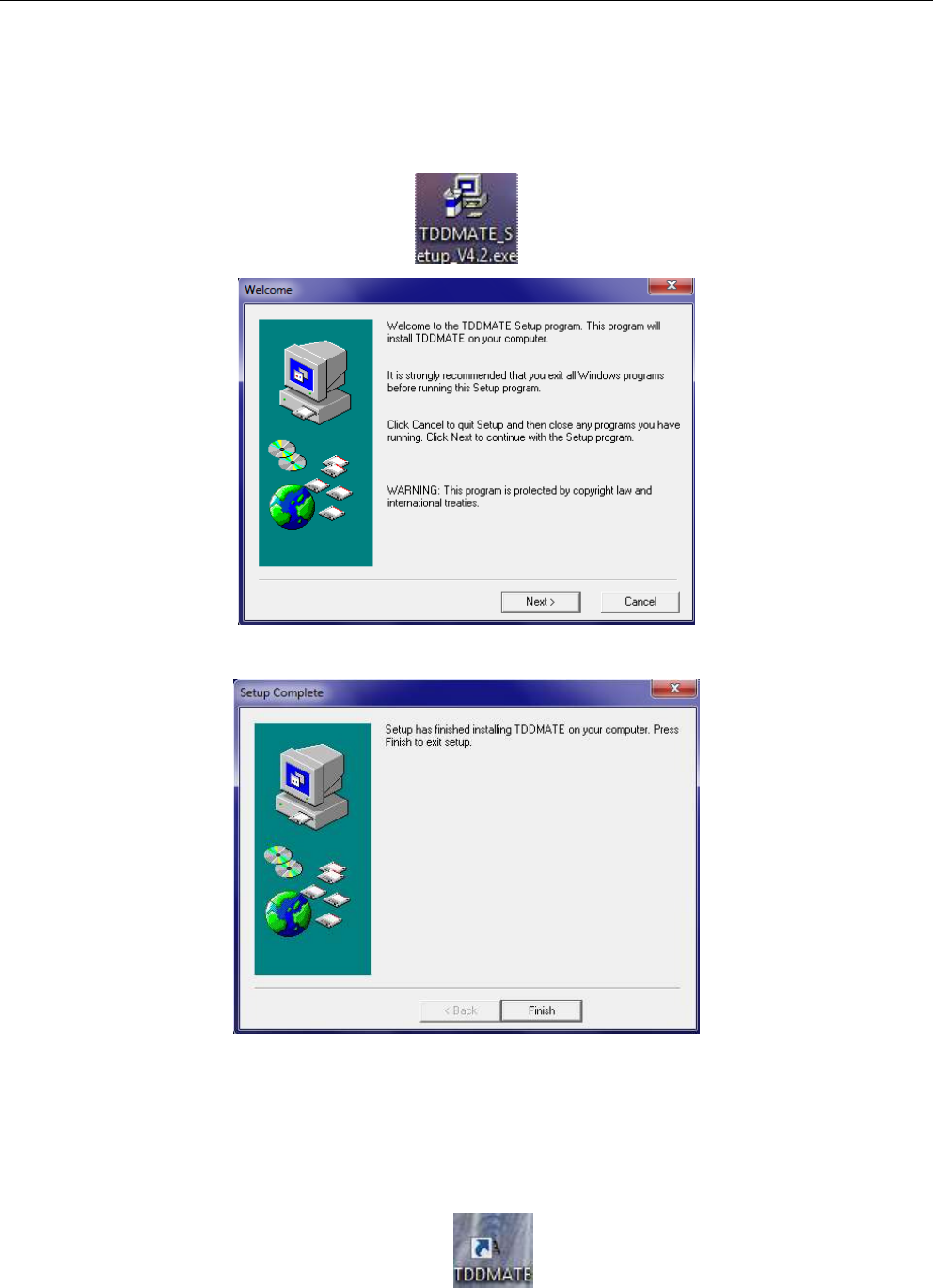
Fujian Helios Technologies Co., Ltd.
www.heliostelecom.com
11
11.3 Software Installation
Click on TDDMATE_Setup_V4.2.exe as following:
Click Next to install the software.
Click Finish to finish the installation.
11.4 Log on
Click shortcut TDDMATE on the desktop as following:
Default User Name: admin
Default Password: admin, click Enter to log on
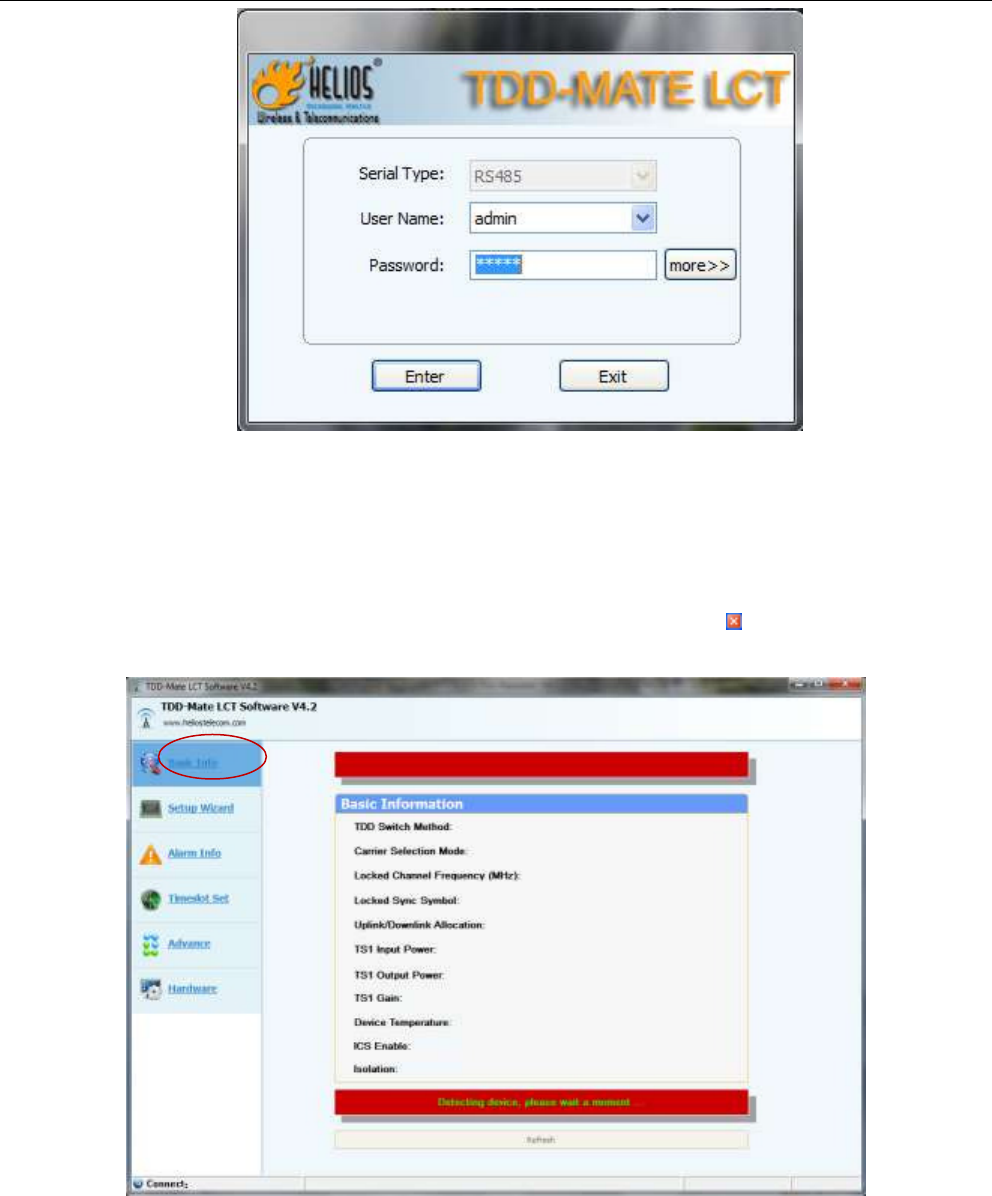
Fujian Helios Technologies Co., Ltd.
www.heliostelecom.com
12
Administrator: has the right to set and query information. The administrator
username and password are available to set from Tool / Management sub-menu.
After successful logon, it will enter into the main windows of TDDMATE LCT Software
V4.2, and shows the default page of “Basic Info”. The main window includes six sub
windows, such as “Basic Info”, “Setup Wizard”, “Alarm Info”, “Timeslot Set”,
“Advance” and “Hardware”. Please refer to “Figure 2”. Click “ ” button on the top right
corner of the main window to log out.
Figure 2 Main Window
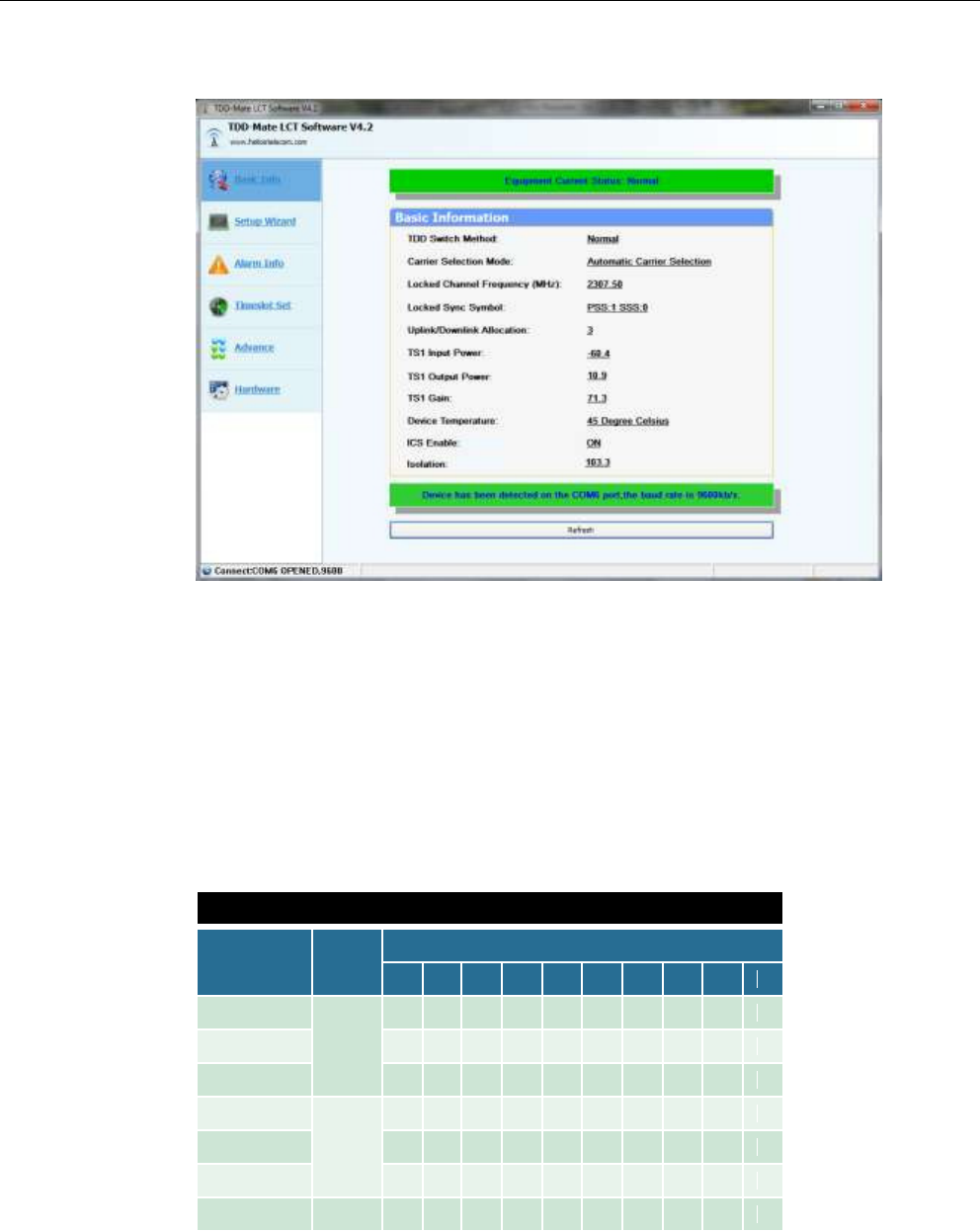
Fujian Helios Technologies Co., Ltd.
www.heliostelecom.com
13
11.5 Basic Info
This window shows basic information of TD-LTE ICS Pico Repeater.
TDD Switch Method: There’re four options: UL Off/DL On, UL On/DL Off, UL
Off/DL Off and Normal
Carrier Selection Mode: Manual/Automatic.
Locked Channel Frequency (MHz): Center frequency of locked channel in
MHz(default working bandwidth: 20MHz which can be customized)
Locked Sync Symbol: PSS(Primary Synchronization Signal): 0~2, SSS
(Secondary Synchronization Signal): 0~167
Uplink/Downlink Allocation: Uplink-Downlink Allocations Configuration.
Following table shows the possible UL/DL allocations configuration (0 to 6):
Uplink-DownlinkAllocations
UL/DL
Configuration
Period
(ms)
Subframe number
0
1
2
3
4
5
6
7
8
9
0
5
D
S
U
U
U
D
S
U
U
U
1
D
S
U
U
D
D
S
U
U
D
2
D
S
U
D
D
D
S
U
D
D
3
10
D
S
U
U
U
D
D
D
D
D
4
D
S
U
U
D
D
D
D
D
D
5
D
S
U
D
D
D
D
D
D
D
6
5
D
S
U
U
U
D
S
U
U
D
TS1 Input Power: Input power of Timeslot 1 in dBm
TS1 Output Power: Output power of Timeslot 1 in dBm
TS1 Gain: System gain of Timeslot 1 in dB
Device Temperature: temperature of the Pico Repeater in degree Celsius.
ICS Enable: switch on/off ICS function.
Isolation: it’s defined as (work gain - isolation).For example, “Isolation: 5” means
work gain is 5dB higher than the isolation between BTS port and MS port.
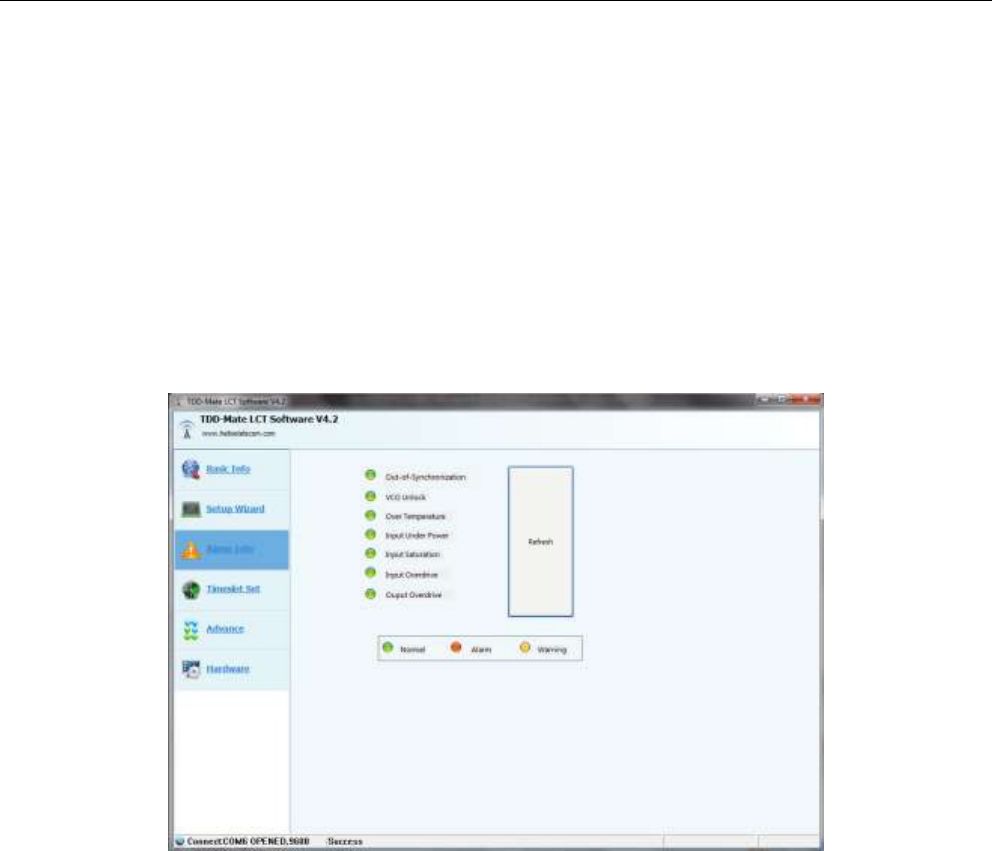
Fujian Helios Technologies Co., Ltd.
www.heliostelecom.com
14
Device has been detected on the COMx port, the baud rate is 9600bps: When
the software is open, it will automatically search available COM port and check if
it’s connected to valid TD-LTE ICS Pico Repeater. “Device has been detected on
the COMx port, the baud rate is 9600bps” means the Pico Repeater is well
connected and users can get information and set parameters now.
PC does not have serial port:“PC does not have serial port” means there’s no
available COM port in the laptop and users should insert one USB-RS232
converter and try again.
Refresh: Click “Refresh” to update the basic information.
11.6 Alarm Info
The “Alarm Info” window shows all detailed information of working status.
Out of Synchronization: Out of synchronization alarm
VCO Unlock: VCO unlock alarm
Over Temperature: Over temperature alarm (default alarm threshold: 85 degree
Celsius)
Input Under Power: Timeslot 1 input power is lower than Sync Threshold
Input Saturation: Timeslot 1 input power is higher than the threshold that the
output power reaches the maximum
Input Overdrive: Timeslot 1 input power is higher than -25dBm
Output Overdrive: Timeslot 1 Output power is higher than 25dBm
Refresh: Click to update working status
Normal: Working status is normal in green
Alarm: In case of alarm items in red, it will switch off the Pico Repeater
Warning: In case of warning items in yellow, it shows warning information only
and the Pico Repeater will continue to be working
11.7 Timeslot Set
As per 3GPP standard, each radio frame consists of 20 Timeslots whose detailed
information can be viewed and set individually.
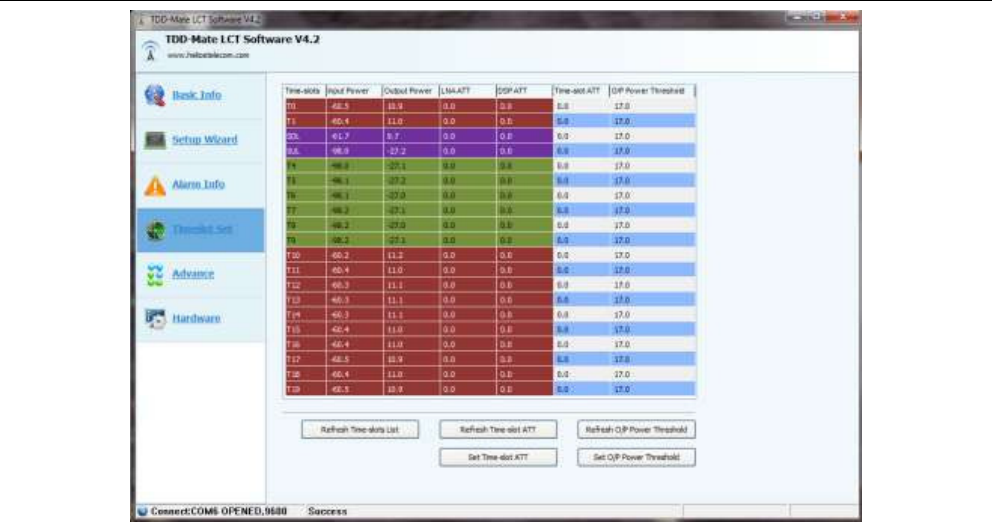
Fujian Helios Technologies Co., Ltd.
www.heliostelecom.com
15
Timeslots: Timeslot number.
Input Power: Input power of the timeslot in dBm.
Output Power: Output power of the timeslot in dBm.
LNA ATT: LNA attenuation in dB.
DSP ATT: DSP attenuation in dB.
Timeslot ATT: Timeslot attenuation in dB.
O/P Power Threshold: Output over power alarm threshold for each timeslot.
Refresh Timeslots List: Update Timeslots information.
Refresh Timeslots ATT: Update Timeslots attenuation information.
Refresh O/P Power Threshold: Update over power alarm threshold information.
Set Timeslots ATT: Modify attenuation value for each timeslot and click Set
timeslots ATT to modify and click Refresh Timeslot ATT to verify.
Set O/P Power Threshold: Modify over power alarm threshold value for each
timeslot and click Set O/P Power Threshold to modify and click Refresh O/P Power
Threshold to verify.
11.8 Advance
The page is mainly for advanced items setting.
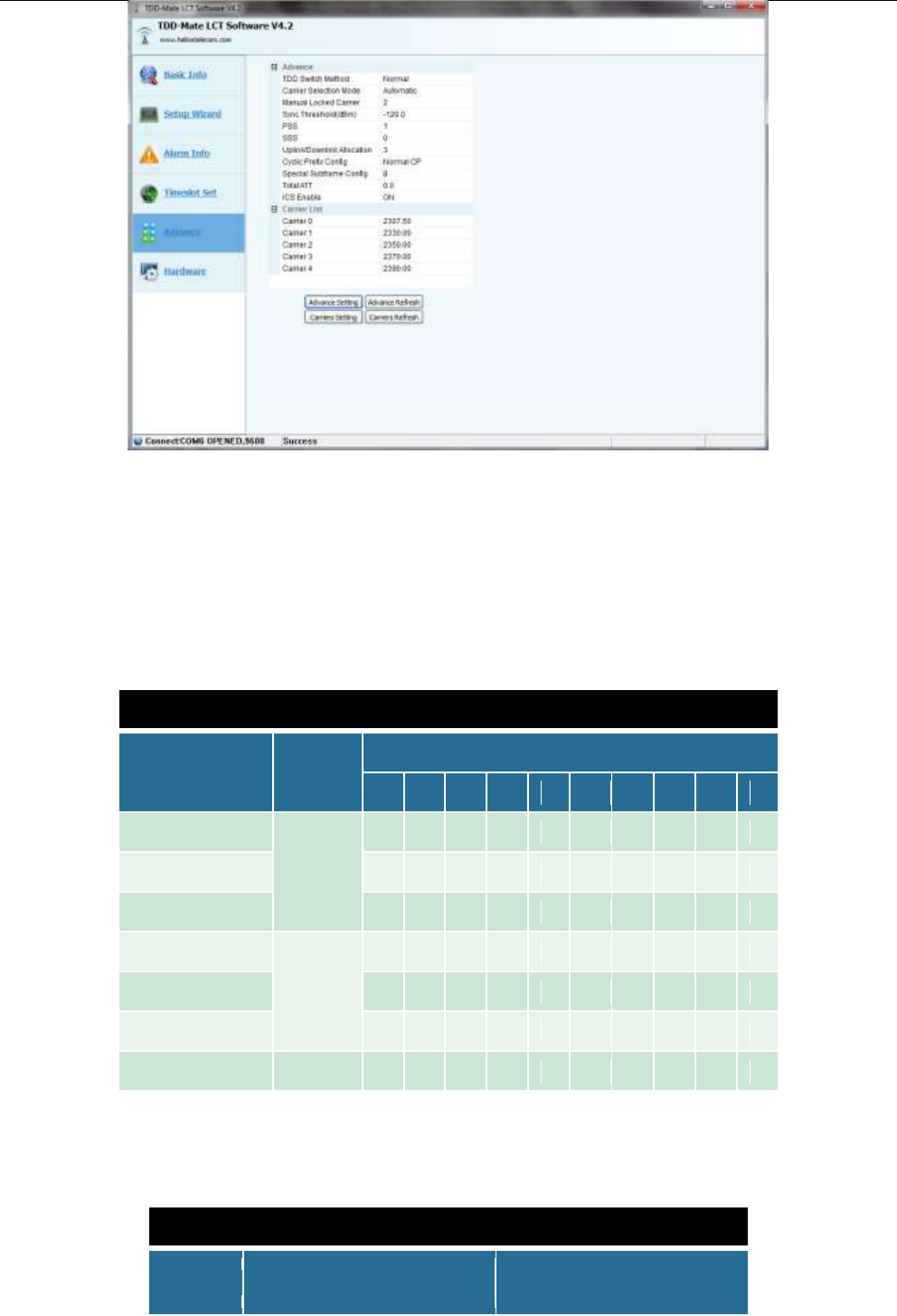
Fujian Helios Technologies Co., Ltd.
www.heliostelecom.com
16
TDD Switch Mode: Including 4 modes of Uplink Off/Downlink On, Uplink
On/Downlink Off, Uplink Off/Downlink Off and Normal
Carrier Selection Method: Manual/Automatic
Manual Locked Carrier: Lock the carrier from the Carrier List
Sync Threshold (dBm): Minimum Timeslot 1 input power for synchronization
PSS: Primary Synchronization Signal
SSS: Secondary Synchronization Signal
Uplink/Downlink Allocation: As per 3GPP standard, there’re 7 kinds of
Uplink/Downlink Allocations as following:
Uplink-Downlink Allocations
UL/DL
Configuration
Period
(ms)
Subframe number
0
1
2
3
4
5
6
7
8
9
0
5
D
S
U
U
U
D
S
U
U
U
1
D
S
U
U
D
D
S
U
U
D
2
D
S
U
D
D
D
S
U
D
D
3
10
D
S
U
U
U
D
D
D
D
D
4
D
S
U
U
D
D
D
D
D
D
5
D
S
U
D
D
D
D
D
D
D
6
5
D
S
U
U
U
D
S
U
U
D
Cyclic Prefix Config: 0 (normal CP) or 1 (Extended CP)
Special Subframe Config: As per 3GPP standard, there’re 9 kinds of Special
Subframe configuration as following:
DwPTS/GP/UpPTS length (OFDM symbols)
Format
Normal CP (Cyclic
Prefix)
Extended CP (Cyclic
Prefix)
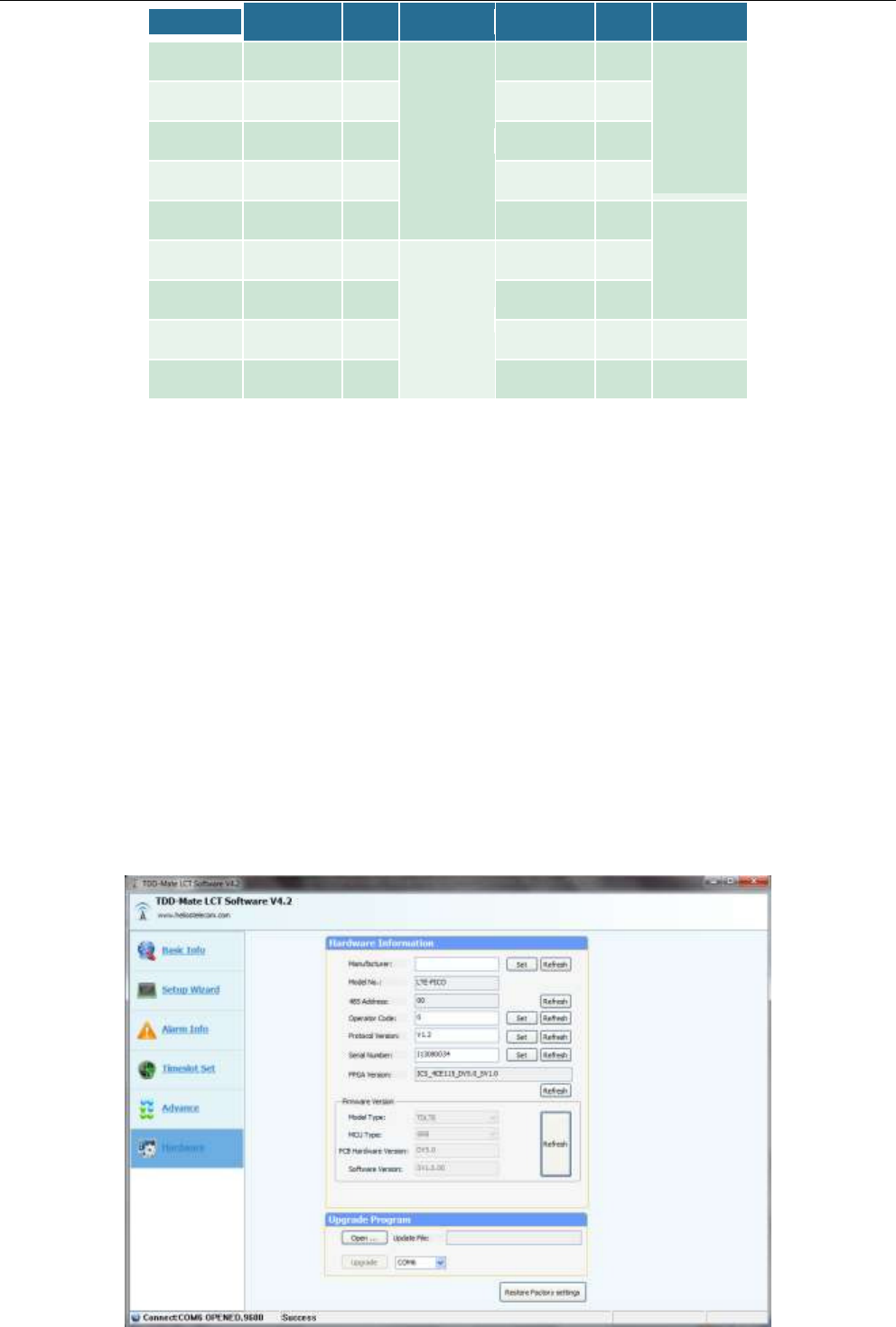
Fujian Helios Technologies Co., Ltd.
www.heliostelecom.com
17
DwPTS
GP
UpPTS
DwPTS
GP
UpPTS
0
3
10
1
3
8
1
1
9
4
8
3
2
10
3
9
2
3
11
2
10
1
4
12
1
3
7
2
5
3
9
2
8
2
6
9
3
9
1
7
10
2
-
-
-
8
1
1
-
-
-
Total ATT: Total system attenuation
ICS Enable: Switch on/off ICS function
Carrier List: It supports up to 5 carriers (default working bandwidth is 20MHz
which can be customized) in the carrier list which can be customized. It’s used for
carrier scanner
Advance Setting: Modify all Advance items and click Advance Setting to accept
Advance Refresh: After advance setting, click Advance Refresh to verify if the
configuration is updated or not
Carrier Setting: Modify the center frequency of all five carriers in Carrier List and
click Carrier Setting to accept
Carriers Refresh: After carrier setting, click Carrier Refresh to verify if the
configuration is updated or not
11.9 Hardware
The page is mainly for “Hardware Information” and “Upgrade Program”
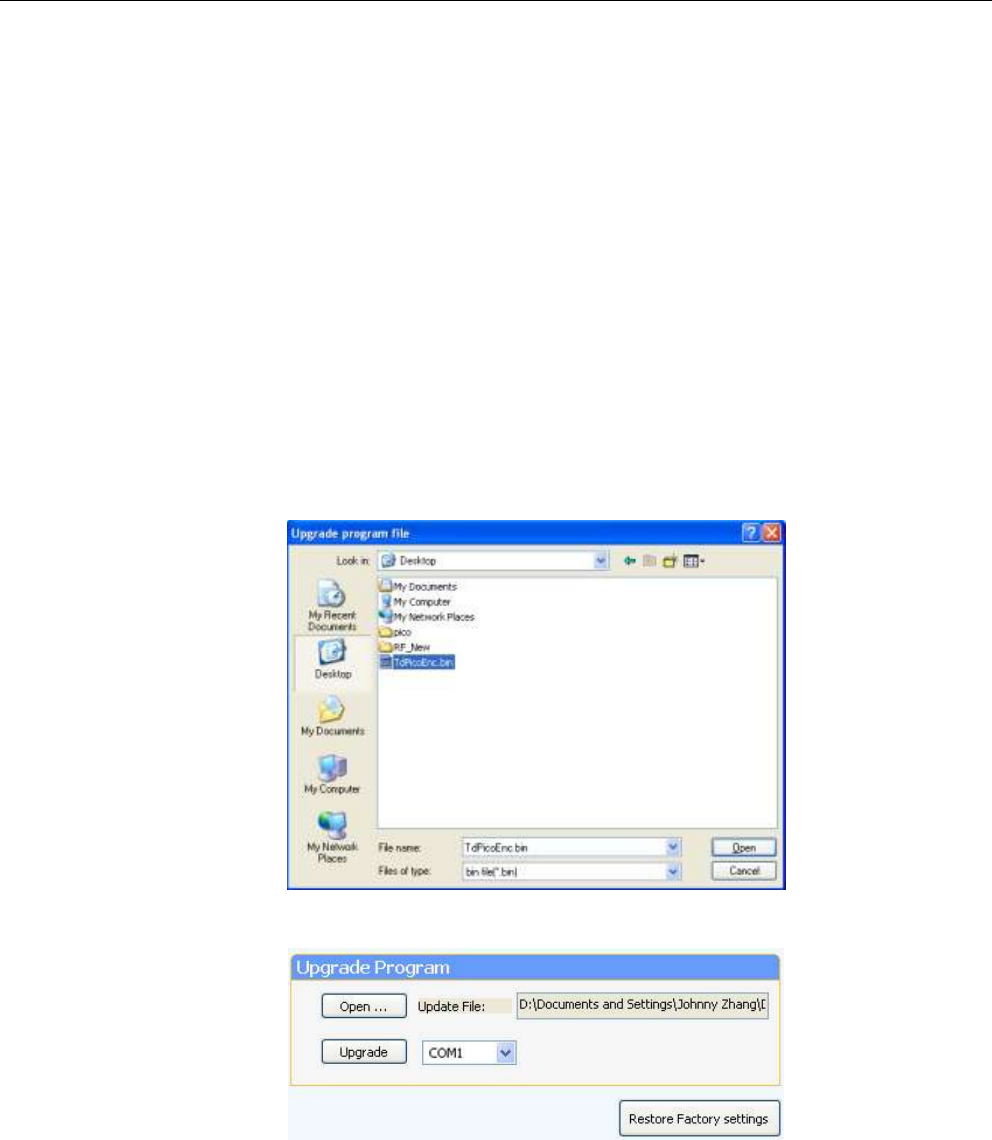
Fujian Helios Technologies Co., Ltd.
www.heliostelecom.com
18
Hardware Information:
Manufacture: default Helios, configurable
Model No: Model number of the Pico Repeater
485 Address: default 00
Operator Code: PLMN code of the operator
Protocol Version: NMS protocol version number
Serial Number: Serial number of the Pico Repeater
FPGA Version: Firmware version number of FPGA
Firmware Version: Firmware version number of ARM
Upgrade Program:
It can upgrade program for ARM only via RS485 port, hardware connection refer to
clause 11.1.
Click Open and select the update file such as TdPicoEnc.bin.
Note: It’s recommended to put the update file into root path of C:\ before upgrade
to avoid unpredictable errors
Click Upgrade to finish the upgrading.
Restore Factory Settings: Restore the default settings from ARM
11.10 Setup Wizard
If users don’t know how to setup the Pico Repeater the first time, setup wizard can
help users step by step. There’re two modes automatic and manual can be selected.
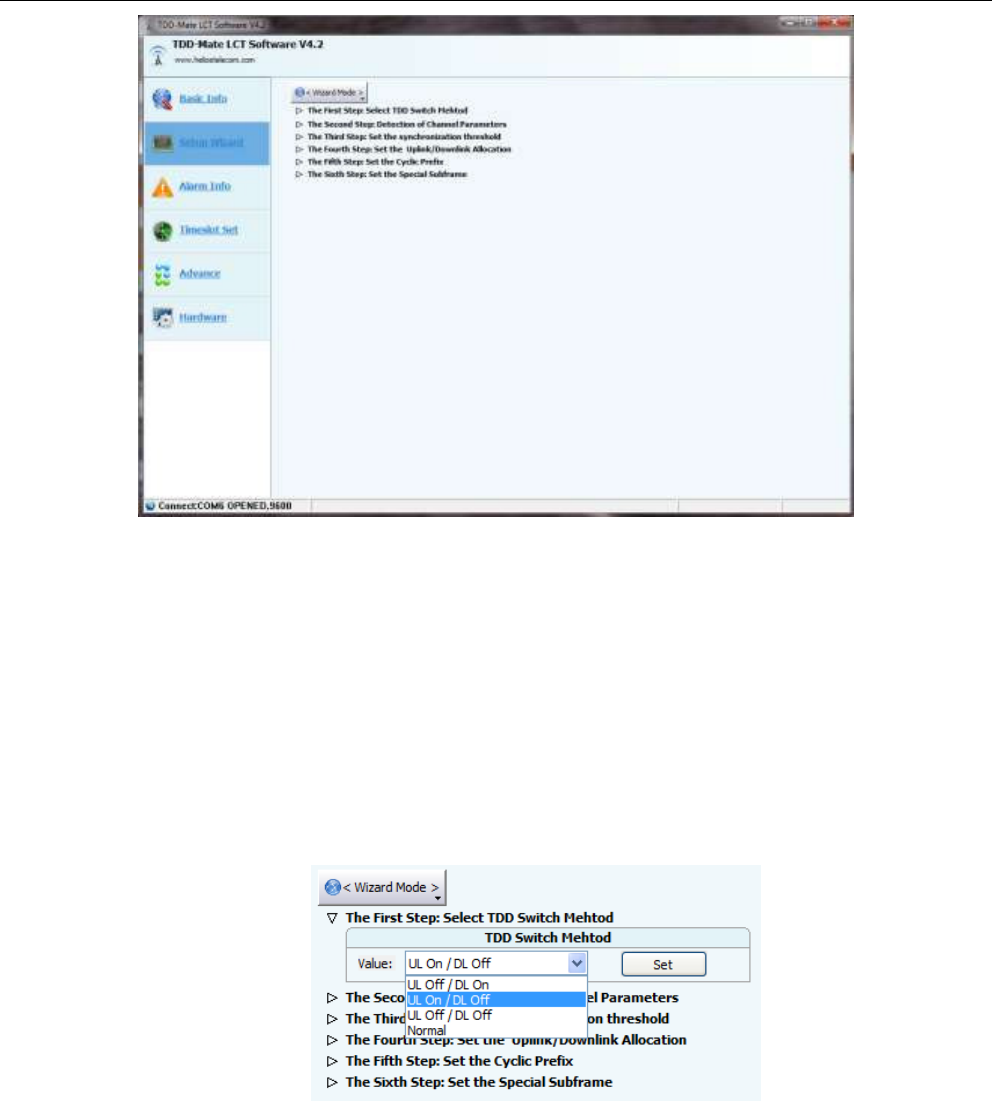
Fujian Helios Technologies Co., Ltd.
www.heliostelecom.com
19
Wizard Mode:
Automatic: In automatic mode, it will scan and lock on the strongest carrier
according to the carrier list, users no need to do anything. However the locked
carrier maybe not the target carrier which users want to use
Manual: In manual mode, it can guide the users to setup the Pico Repeater step
by step. Following is the detailed description of manual wizard:
The 1st Step: Select TDD Switch Method
Since in TDD system, working frequency is the same for both uplink and downlink, it’s
necessary to switch off downlink during uplink test in the lab, and vice versa.
UL Off / DL On: Switch off uplink and switch on downlink for downlink testing
UL On / DL Off: Switch off downlink and switch on uplink for uplink testing
UL Off / DL Off: Switch off uplink and downlink
Normal: Under normal mode which should be used on site, it automatically
switches on uplink and downlink alternately according to sync signal
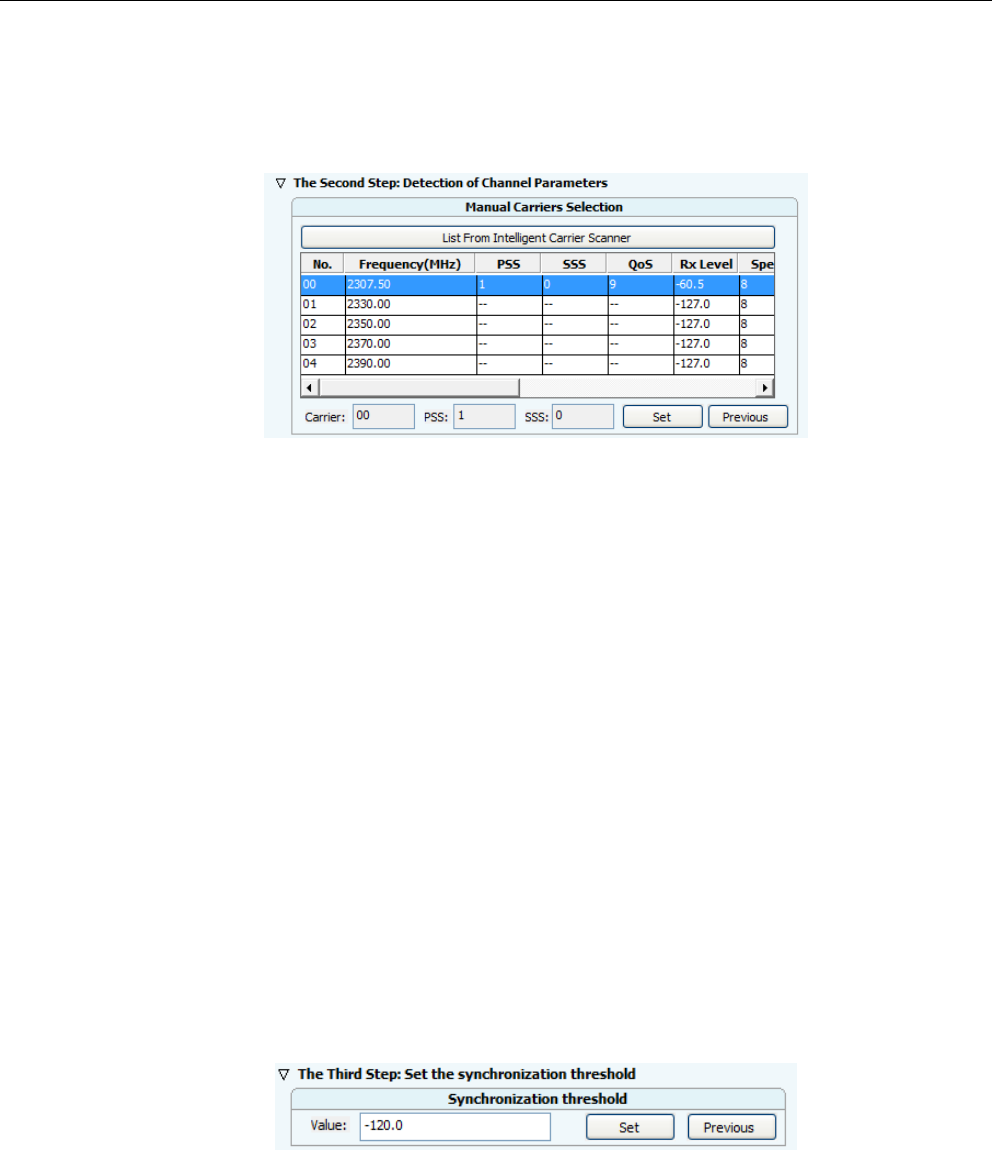
Fujian Helios Technologies Co., Ltd.
www.heliostelecom.com
20
The 2nd Step: Detection of Channel Parameters
It supports up to 5 carriers (default working bandwidth is 20MHz which can be
customized) in the carrier list which can be customized
List from Intelligent Carrier Scanner: Click this button to get detailed
information of all carriers within the carrier list
No: Carrier number
Frequency: Center frequency of the carrier in MHz
PSS: Primary Synchronization Signal
SSS: Secondary Synchronization Signal
QoS: Quality of Service which is defined by Helios. It’s based on 10 times of
statistics, the value in QoSbox means the successful times to get SSS code.
Higher QoS, better quality of service
Rx Level: Timeslot 1 input power in dBm
Special Subframe: 0 (normal CP) or 1 (Extended CP)
Uplink/Downlink Allocation: Uplink/Downlink allocation, 0~6
Cyclic Prefix: 0 (normal CP) or 1 (Extended CP)
Operator Code: PLMN code of the operator
Set: Click on target carrier and click Set to lock on it
Previous: Back to previous page
The 3rd Step: Set the Synchronization Threshold
If the input power is too weak to ensure normal synchronization, then the Pico
Repeater cannot be normal working, in such case, it’s necessary to switch off the Pico
Repeater to avoid interference
Synchronization threshold: If the Rx Level is less than the synchronization
threshold (default -90dBm, configurable), it will switch off the Pico Repeater
Value: Minimum Rx Level for synchronization in dBm
Set: Input minimum Rx Level in Value box and click Set to modify the threshold
Previous: Back to previous page
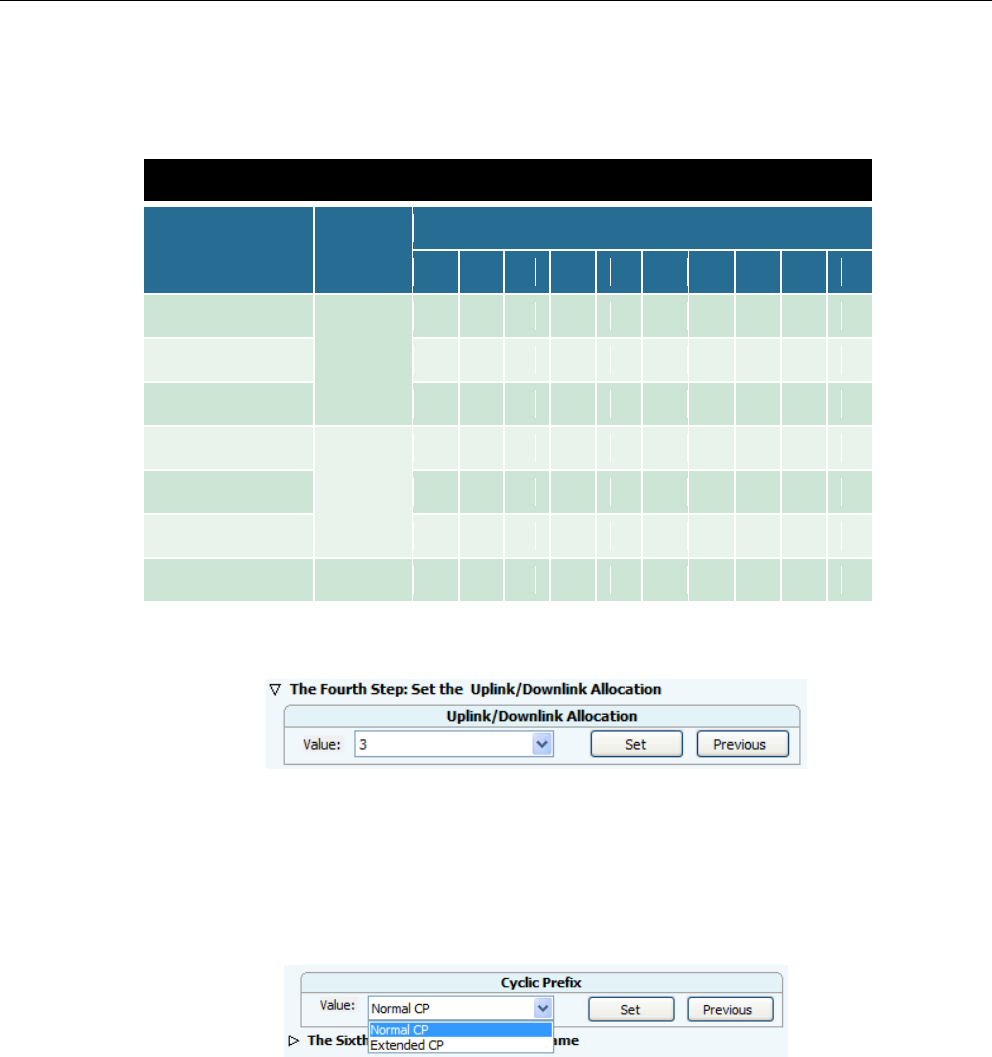
Fujian Helios Technologies Co., Ltd.
www.heliostelecom.com
21
The 4th Step: Set the Uplink/Downlink Allocation
As per 3GPP standard, there’re 7 kinds of Uplink/Downlink Allocations as following:
Users should select appropriate configuration number according to BTS’ configuration
Value: Range: 0~6
Set: Select configuration number in Value box and click Set to modify the
allocation
Previous: Back to previous page
The 5th Step: Set the Cyclic Prefix
Value: Normal CP or Extended CP
Set: Select CP type in Value box and click Set to modify
Previous: Back to previous page
Uplink-Downlink Allocations
UL/DL
Configuration
Period
(ms)
Subframe number
0
1
2
3
4
5
6
7
8
9
0
5
D
S
U
U
U
D
S
U
U
U
1
D
S
U
U
D
D
S
U
U
D
2
D
S
U
D
D
D
S
U
D
D
3
10
D
S
U
U
U
D
D
D
D
D
4
D
S
U
U
D
D
D
D
D
D
5
D
S
U
D
D
D
D
D
D
D
6
5
D
S
U
U
U
D
S
U
U
D
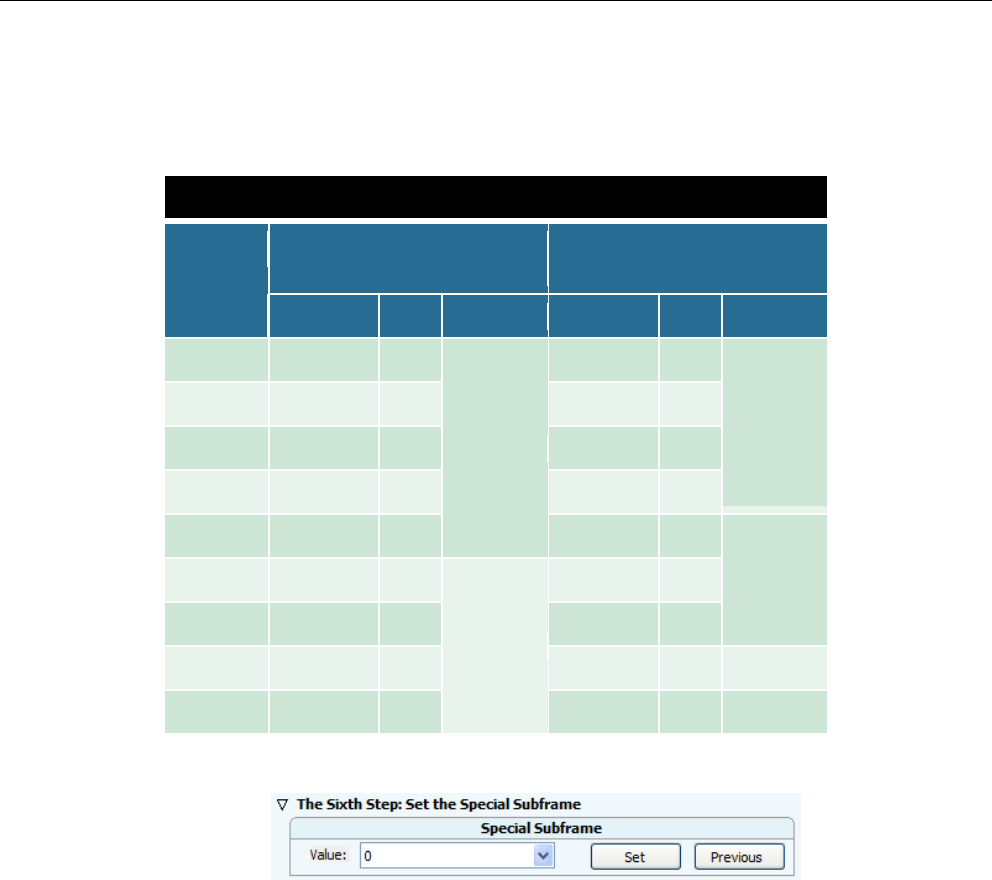
Fujian Helios Technologies Co., Ltd.
www.heliostelecom.com
22
The 6th Step: Set the Special Subframe
As per 3GPP standard, there’re 9 kinds of Special Subframe configuration as
following:
DwPTS/GP/UpPTS length (OFDM symbols)
Format
Normal CP(Cyclic
Prefix)
Extended CP(Cyclic
Prefix)
DwPTS
GP
UpPTS
DwPTS
GP
UpPTS
0
3
10
1
3
8
1
1
9
4
8
3
2
10
3
9
2
3
11
2
10
1
4
12
1
3
7
2
5
3
9
2
8
2
6
9
3
9
1
7
10
2
-
-
-
8
1
1
-
-
-
Users should select appropriate configuration number according to BTS’ configuration
Value: Range: 0~8
Set: Input configuration number in Value box and click Set to modify
Previous: Back to previous page

Fujian Helios Technologies Co., Ltd.
www.heliostelecom.com
23
Helios® Single Band Digital TD-LTE
ICSPico Repeater User Manual
Edition 3.0 (August 2012)
© 2012 Fujian Helios Technologies Co., Ltd.
All rights reserved.
Information in this guide is subject to change without notice.
